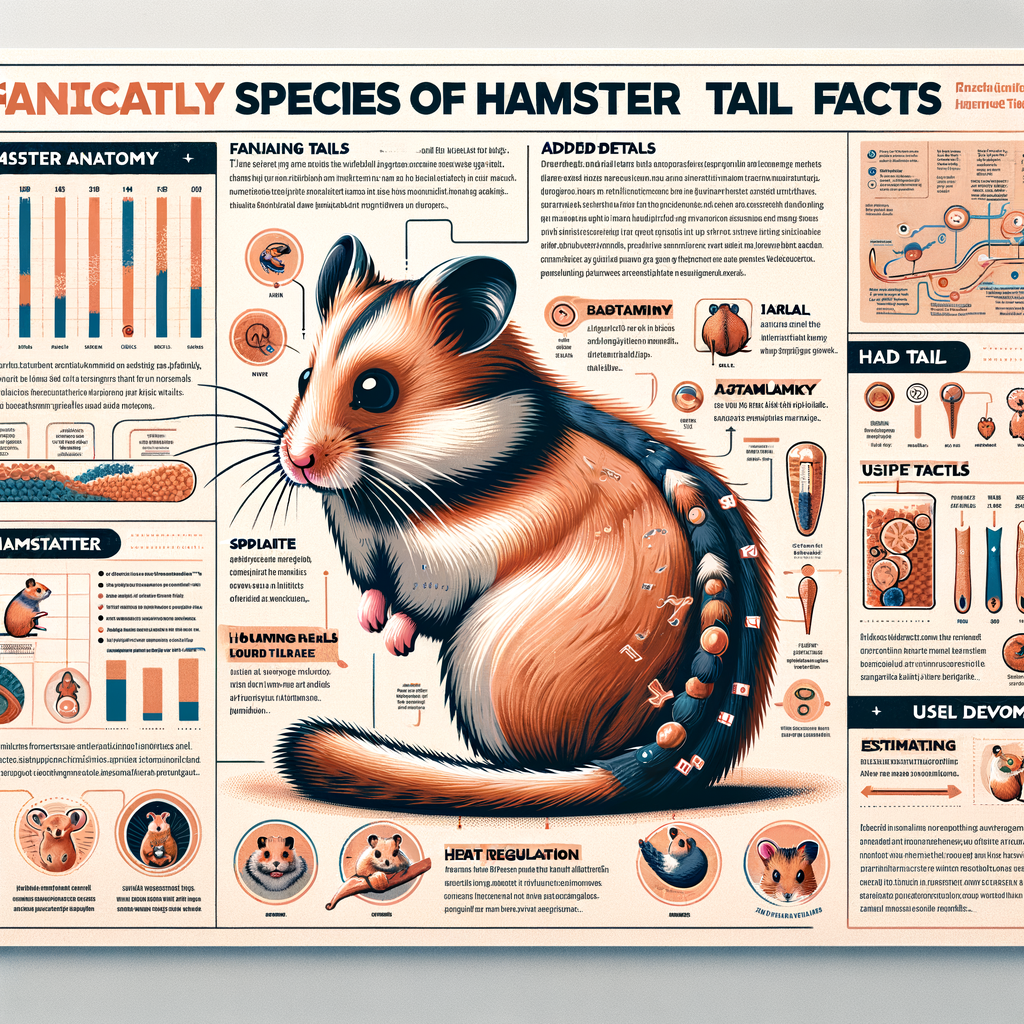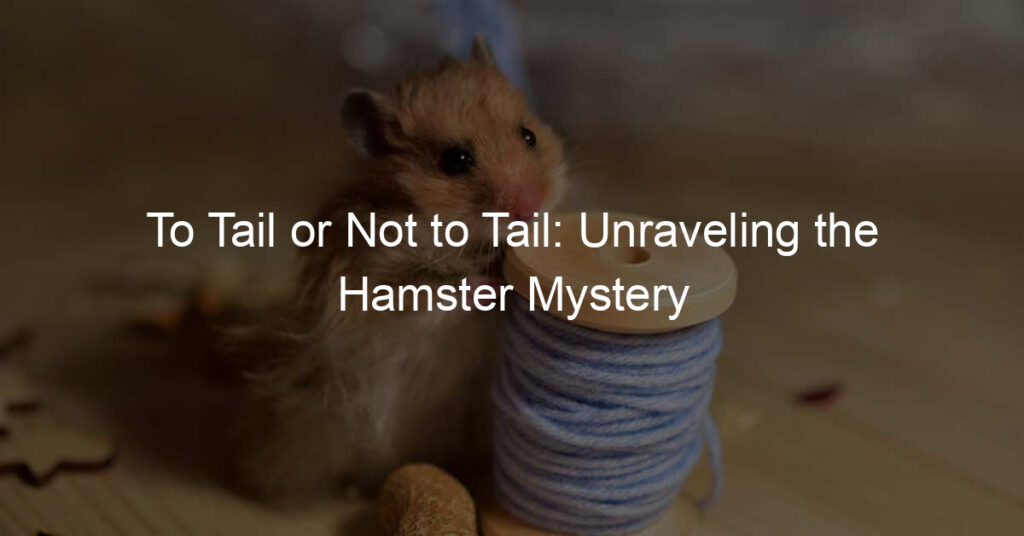
Introduction to Hamster Anatomy
Hamsters are small, fascinating creatures that have been popular pets for many years. Despite their small size, they have a complex anatomy that is worth understanding. In this section, we will delve into the basic structure of a hamster and the key differences in anatomy among different hamster species.
- Understanding the basic structure of a hamster
- Key differences in anatomy among different hamster species
Hamsters are rodents, and like all rodents, they have certain common features. They have a compact body, short legs, and a short tail. Their body is divided into three main parts: the head, the torso, and the tail. The head houses the brain, eyes, ears, and mouth. The torso contains the heart, lungs, stomach, and other vital organs. The tail, though short, plays a crucial role in balance and communication.
One unique feature of hamsters is their cheek pouches. These pouches extend from their cheeks to their shoulders and are used to store food. Hamsters have sharp incisors that never stop growing, which they use to gnaw on food and objects to keep them from overgrowing.
There are several species of hamsters, and while they share many similarities, there are also some key differences in their anatomy. For instance, the Syrian hamster, also known as the golden hamster, is the largest of the pet hamsters. They have a stout body and a short tail. On the other hand, dwarf hamsters, such as the Roborovski and Campbell’s dwarf hamsters, are much smaller and have a more elongated body shape.
Another difference lies in the length and density of their fur. Syrian hamsters have short, dense fur, while some dwarf hamsters have longer, silky fur. The color of their fur also varies widely among species, ranging from golden to white, brown, black, and even grey.
Understanding the anatomy of your hamster can help you better care for them and recognize any signs of illness or distress. In the following sections, we will delve deeper into the unique features of hamster anatomy, focusing on their tails and how it affects their care.
Hamster Tails: A Unique Appendage
Hamsters are small, adorable creatures that are often kept as pets. One of the most distinctive features of a hamster is its tail. But have you ever wondered why a hamster has a tail and what purpose it serves? Let’s delve into the fascinating world of hamster tails.
Understanding Hamster Tails
Hamster tails are not just there for decoration. They play a crucial role in the life of a hamster. Let’s explore the function of a hamster’s tail and how it contributes to its overall anatomy.
- The function of a hamster’s tail
- How a hamster’s tail contributes to its overall anatomy
Unlike some animals that use their tails for balance or communication, the primary function of a hamster’s tail is temperature regulation. Hamsters are desert animals, and their tails help them to cope with the extreme temperatures of their natural habitat. The tail acts as a heat dissipater, releasing excess body heat to help the hamster stay cool.
The tail of a hamster is a vital part of its anatomy. It is short and stubby, typically measuring between 1 to 2 centimeters in length. This short length helps to minimize heat loss, a critical survival feature in the cold desert nights. The tail also contains a small amount of fat, which the hamster can use as an energy reserve in times of scarcity.
In conclusion, the tail of a hamster is a fascinating and essential appendage. It plays a crucial role in temperature regulation and survival, making it a unique and vital part of the hamster’s anatomy.
Hamster Tail Facts
- Fact 1: Unlike many other rodents, hamsters have short tails. The length of a hamster’s tail usually ranges from 0.2 inches to 0.6 inches, depending on the breed. This short tail helps them to maintain balance and navigate their environment.
- Fact 2: Hamster tails are covered in a short, fine layer of fur. This fur serves a critical function – it helps to keep the hamster warm. In the wild, hamsters live in cold climates, so every bit of insulation helps!
- Fact 3: Hamsters use their tails for communication. By moving their tail in different ways, they can signal various emotions or intentions to other hamsters. For example, a hamster might wag its tail when it’s excited or happy.
Tailless Hamsters: A Different Breed
Hamsters are known for their cute, fluffy appearance and their small size. But did you know that there are some hamsters that are born without tails? These tailless hamsters are a different breed altogether and have their own unique characteristics.
Understanding Tailless Hamsters
Let’s dive deeper into understanding these unique creatures.
- Why some hamsters are born without tails
- How tailless hamsters differ from other hamster species
Some hamsters are born without tails due to genetic mutations. This is a natural occurrence and does not affect the hamster’s health or lifespan. In fact, these tailless hamsters are just as active and playful as their tailed counterparts.
Tailless hamsters differ from other hamster species in a few ways. Firstly, they lack the tail that is characteristic of most hamster species. This gives them a unique appearance, making them stand out in a crowd of hamsters. Secondly, tailless hamsters often have a more rounded body shape due to the absence of a tail. Lastly, tailless hamsters may have different behavioral patterns compared to other hamster species. For instance, they may be more inclined to burrow and hide, as they do not have a tail to help them balance on top of surfaces.
In conclusion, tailless hamsters are a unique breed with their own set of characteristics. Despite their lack of a tail, these hamsters are just as healthy and active as any other hamster species. So, if you’re considering getting a hamster, don’t overlook these tailless wonders!
Hamster Tail or No Tail: The Differences
Hamsters are fascinating creatures, each with their unique characteristics. One of the most intriguing differences is between tailed and tailless hamsters. Let’s explore these differences.
- Difference 1: Physical Appearance
- Difference 2: Climbing Abilities
The most noticeable difference between tailed and tailless hamsters is their physical appearance. Tailed hamsters, like the Chinese hamster, have a small but visible tail. On the other hand, tailless hamsters, such as the Syrian hamster, have a stub or no tail at all. This difference is a result of their unique genetic makeup.
Another significant difference between tailed and tailless hamsters is their climbing abilities. Tailed hamsters, with their small tails, have better balance and are more adept climbers. They can easily navigate through tunnels and climb on hamster wheels. Tailless hamsters, however, are not as agile climbers. Their lack of a tail affects their balance, making climbing a bit more challenging for them.
In conclusion, whether a hamster has a tail or not plays a significant role in its physical appearance and abilities. Understanding these differences can help you provide the best care for your pet hamster, tail or no tail.
Hamster Care: Tail or No Tail
Whether your hamster has a tail or not, it’s important to understand how to properly care for them. In this section, we will focus on caring for a tailed hamster.
Caring for a Tailed Hamster
Tailed hamsters, like all pets, require special attention and care. Here are some key points to remember and common issues you may encounter when caring for a tailed hamster.
- Key points to remember when caring for a tailed hamster
- Common issues and solutions in tailed hamster care
Firstly, it’s important to note that a hamster’s tail is a sensitive part of their body. Avoid pulling or tugging on it. When handling your hamster, be gentle and supportive. Secondly, keep their habitat clean and comfortable. A dirty habitat can lead to infections and diseases. Lastly, ensure your hamster gets plenty of exercise. A hamster wheel in their cage is a great way for them to stay active and healthy.
One common issue is tail injury. If your hamster’s tail appears injured, it’s important to seek veterinary care immediately. Another issue is obesity. This can be prevented by providing a balanced diet and plenty of exercise. Lastly, stress can be a problem for hamsters. Ensure their habitat is quiet and calm, and handle them gently to reduce stress.
In conclusion, caring for a tailed hamster requires attention, patience, and knowledge. By following these tips, you can ensure your hamster lives a happy and healthy life.
Caring for a Tailless Hamster
Just like their tailed counterparts, tailless hamsters also require special attention and care. Here are some key points to remember and common issues you might face when caring for a tailless hamster.
- Key points to remember when caring for a tailless hamster
- Proper Housing: Tailless hamsters are agile climbers. Ensure their cage has no high platforms they could fall from.
- Diet: A balanced diet is crucial. Provide a mix of hamster-safe fruits, vegetables, and high-quality hamster pellets.
- Exercise: Regular exercise is vital. Provide a hamster wheel and toys for mental stimulation.
- Handling: Handle your hamster gently. Avoid picking them up from the tail area as it can cause discomfort.
- Common issues and solutions in tailless hamster care
- Obesity: If your hamster is gaining weight, reduce their food intake and increase their exercise.
- Loneliness: Hamsters are social animals. If they seem lonely, consider getting another hamster of the same sex.
- Aggression: If your hamster is showing signs of aggression, they might be stressed. Make sure their environment is calm and quiet.
- Health Issues: Regular vet check-ups can help detect and treat any potential health issues early.
Tailless hamsters, also known as Manx hamsters, have their own unique needs. Here are some important points to keep in mind:
Despite your best efforts, you might encounter some issues when caring for a tailless hamster. Here are some common problems and their solutions:
In conclusion, caring for a tailless hamster requires understanding their unique needs and being proactive in their care. With the right approach, your tailless hamster can lead a happy and healthy life.
Conclusion: The Mystery of the Hamster Tail
As we reach the end of our journey into the fascinating world of hamster tails, it’s time to recap the key points and share some final thoughts on this intriguing subject.
- Recap of key points discussed in the article:
- Final thoughts on the hamster tail mystery:
We began with a brief introduction to hamster anatomy, highlighting the unique features that make these creatures so special. We then delved into the specifics of hamster tails, discussing their unique structure and function. We learned that not all hamsters have tails, and explored the different breeds that are tailless. We also discussed the importance of proper hamster care, whether your furry friend has a tail or not.
The mystery of the hamster tail is a fascinating one. Despite their small size, these appendages play a crucial role in the life of a hamster. They provide balance, aid in communication, and even serve as a heat regulator. Whether your hamster has a tail or not, it’s clear that these creatures are wonderfully complex and deserve our respect and care.
As we conclude, remember that understanding your hamster’s anatomy, including its tail, can help you provide the best care possible. The more you know, the better you can meet your hamster’s needs and ensure it lives a long, healthy, and happy life.
So, the next time you watch your hamster scurrying around, take a moment to appreciate the wonder of its tail. It’s not just a cute appendage, but a remarkable tool that showcases the incredible adaptability of nature.








